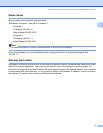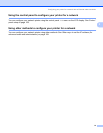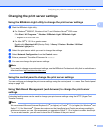
Configuring your printer for a network with an Ethernet cable connection
10
2
IP addresses, subnet masks and gateways 2
To use the printer in a networked TCP/IP environment, you need to configure the IP address and subnet
mask. The IP address you assign to the print server must be on the same logical network as your host
computers. If it is not, you must properly configure the subnet mask and the gateway address.
IP address 2
An IP address is a series of numbers that identifies each computer connected to a network. An IP address
consists of four numbers separated by dots. Each number is between 0 and 255.
Example: In a small network, you would normally change the final numbers.
• 192.168.1.1
• 192.168.1.2
• 192.168.1.3
How the IP address is assigned to your print server: 2
If you have a DHCP/BOOTP/RARP server in your network (typically a UNIX
®
/Linux, Windows
®
2000/XP,
Windows Vista™, or Windows Server
®
2003 network) the print server will automatically obtain its IP address
from the server and register its name with any RFC 1001 and 1002-compliant dynamic name services.
Note
On smaller networks, the DHCP server may be the router.
For more information on DHCP, BOOTP and RARP, see Using DHCP to configure the IP
address on page 159, Using BOOTP to configure the IP address on page 159 and Using RARP to configure
the IP address on page 160.
If you do not have a DHCP/BOOTP/RARP server, the Automatic Private IP Addressing (APIPA) protocol will
automatically assign an IP address from the range 169.254.1.0 to 169.254.254.255. For more information on
APIPA, see Using APIPA to configure the IP address on page 161.
If the APIPA protocol is disabled, the IP address of a Brother print server is 192.0.0.192. However, you can
easily change this IP address number to match with the IP address details of your network. For information
on how to change the IP address, see Setting the IP address and subnet mask on page 12.


















